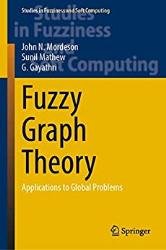 Название: Fuzzy Graph Theory: Applications to Global Problems
Название: Fuzzy Graph Theory: Applications to Global ProblemsАвтор: John N. Mordeson, Sunil Mathew, G. Gayathri
Издательство: Springer
Серия: Studies in Fuzziness and Soft Computing
Год: 2023
Страниц: 265
Язык: английский
Формат: pdf (true), epub
Размер: 24.1 MB
This book examines some issues involving climate change, human trafficking, and other serious world challenges made worse by climate change. In the fuzzy graph theory part of the book, the relatively new concepts of fuzzy soft semigraphs and graph structures are used to study human trafficking, as well as its time intuitionistic fuzzy sets that have been introduced to model forest fires. The examination of return refugees to their origin countries is undertaken. The neighborhood connectivity index is determined for trafficking in various regions in the world. Outside the area of fuzzy graph theory, a new approach to examine climate change is introduced. Social network theory is used to study feedback processes that effect climate forcing. Nonstandard analysis is a possible new area that could be used by scholars of mathematics of uncertainty. A foundation is laid to aid the researcher in the understanding of nonstandard analysis. In order to accomplish this, a discussion of some basic concepts from first-order logic is presented as some concepts of mathematics of uncertainty. An application to the theory of relativity is presented.
It is well-known that the use of fuzzy logic is an ideal way to model situations described linguistically. Because of the complexity of a directed graph used to model trafficking and because of the lack of accurate data to measure the flow, fuzzy graphs provide an ideal method of modeling trafficking of persons and illegal immigration. Knowing the structure of a fuzzy-directed graph can be used in many ways to deal with the flow. One way is to determine countries that could be targeted for the purpose of reducing the flow. Another way would be to determine the countries that could be targeted to increase their government response or decrease their vulnerability.
In a world experiencing climate change, past assumptions about the weather no longer hold true. Climate data may be available, but it is often hard to find, understand, and apply to decision making. Climate scientists around the world are contributing to simulation models of the future climate. Their aim is to produce critical information to assist decision-makers struggling to effectively plan for the future, but much of their output remains beyond the understanding of end-users and thus cannot be integrated into policies. Thus due to the lack of precise data available, techniques from mathematics of uncertainty may be useful. To overcome the challenges faced by climate change, cooperation among various agencies, companies, and scholars is needed. Techniques from mathematics of uncertainty may be helpful.
Chapter 1 discusses some of the basic material required for the development of this book, especially for the smooth reading of Chaps. 6–10. Fundamental definitions and results from fuzzy sets, fuzzy relations, fuzzy graphs, and fuzzy incidence graphs are presented.
In Chap. 2, we lay a foundation for a new research area in fuzzy mathematics, namely nonstandard analysis. In order for a scholar to fully understand nonstandard analysis, an understanding of order first logic is necessary. Consequently, we begin this chapter with a discussion of first-order logic and a proof of the transfer principle. We follow this by proving some of the basic results of nonstandard analysis. We then introduce some concepts of mathematics of uncertainty to nonstandard analysis. The chapter is concluded by using concepts of mathematics of uncertainty to the theory of relativity.
In Chap. 3, we introduce a new approach by introducing methods from social network theory to model feedback processes in climate change. Feedback processes amplify or diminish the effect of each climate forcing, i.e., a change which may push the climate system in the direction of warming or cooling.
In Chap. 4, we determine the similarity of country rankings of countries with respect a country’s vulnerability ranking by the ND-Gain Scores and the ranking of countries concerning climate risk of Fragile Planet.
In Chap. 5, we use the notion of a time intuitionistic fuzzy set first introduced to model forest fires in order to apply these ideas to study human trafficking.
Chapter 6 focuses on a new development in fuzzy graph theory called directed fuzzy incidence graphs, abbreviated as DFIG. This new model is very effective in dealing with networks influenced by external parameters. Modern networks like Internet and big highway systems can be modeled using this concept. Legal flow enhancing and illegal flow reduction techniques are discussed using different nodes, arcs and pairs of the network. The most important problem of networking theory is the enhancement of effective flow from one node to another.
Chapter 7 concentrates on results and discussions to improve flow in directed fuzzy incidence networks (DFIN). Concepts like effective flow and maximum flow are discussed. Flow enhancement and saturation are other major topics considered. A DFIN version of max-flow min-cut theorem also is presented.
Chapter 8 mainly deals with two new parameters associated with fuzzy graphs termed as cycle connectivity and cycle cogency. Reachability is the most desired quality of any network. If two nodes are reachable in two different directions, they are said to be cyclically reachable. Cyclic reachability is the theme of Chap. 8. Several different types of graphs are also investigated.
In Chap. 9, a fuzzy graph parameter named as neighborhood connectivity index (NCI) is discussed. It is effective in dealing with the local imbalance problems of a network. NCI of different types of products of fuzzy graphs is also presented.
The final Chapter 10 deals with cyclic connectivity index and integrity index of fuzzy graphs. These graph parameters reflect the cyclic reachability and average cyclic reachability of the fuzzy graph. Algorithms for the computation of the indices are provided. A new sequence termed as cyclic status sequence connecting graph space to sequence space is studied.
Скачать Fuzzy Graph Theory: Applications to Global Problems